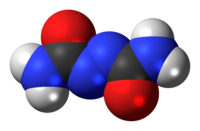Azodicarbonamide
 |
|
 |
|
| Names | |
|---|---|
|
IUPAC name
Carbamoyliminourea
|
|
| Other names
Azodicarboxamide; Azobisformamide; C,C'-Azodi(formamide); Diazenedicarboxamide
|
|
| Identifiers | |
|
123-77-3 |
|
| 3D model (Jmol) | Interactive image |
| ChEMBL |
ChEMBL28517 |
| ChemSpider |
4575589 |
| ECHA InfoCard | 100.004.229 |
| EC Number | 204-650-8 |
| E number | E927a (glazing agents, ...) |
| PubChem | 31269 |
| UNII |
56Z28B9C8O |
|
|
|
|
| Properties | |
| C2H4N4O2 | |
| Molar mass | 116.08 g·mol−1 |
| Appearance | Yellow to orange/red crystalline powder |
| Melting point | 225 °C (437 °F; 498 K) (decomposes) |
| Hazards | |
| Safety data sheet | [1] |
|
EU classification (DSD)
|
Harmful (Xn) |
| R-phrases | R42 R44 |
| S-phrases | S22 S24 S37 |
| NFPA 704 | |
|
Except where otherwise noted, data are given for materials in their standard state (at 25 °C [77 °F], 100 kPa).
|
|
|
|
|
| Infobox references | |
Azodicarbonamide, or azo(bis)formamide, is a chemical compound with the molecular formula C2H4O2N4. It is a yellow to orange-red, odorless, crystalline powder.
The principal use of azodicarbonamide is in the production of foamed plastics as a blowing agent. The thermal decomposition of azodicarbonamide results in the evolution of nitrogen, carbon monoxide, carbon dioxide, and ammonia gases, which are trapped in the polymer as bubbles to form a foamed article.
Azodicarbonamide is used in plastics, synthetic leather, and other industries and can be pure or modified. Modification affects the reaction temperatures. Pure azodicarbonamide generally reacts around 200 °C. In the plastic, leather, and other industries, modified azodicarbonamide (average decomposition temperature 170 °C) contains additives that accelerate the reaction or react at lower temperatures.
An example of the use of azodicarbonamide as a blowing agent is found in the manufacture of vinyl (PVC) foam, where it plays a role in the formation of air bubbles by breaking down into gas at high temperature. Vinyl foam is springy and does not slip on smooth surfaces. It is useful for carpet underlay and floor mats. Commercial yoga mats made of vinyl foam have been available since the 1980s; the first mats were cut from carpet underlay.
As a food additive, azodicarbonamide is used as a flour bleaching agent and a dough conditioner. It reacts with moist flour as an oxidizing agent. The main reaction product is biurea, a derivative of urea, which is stable during baking. Secondary reaction products include semicarbazide and ethyl carbamate. It is known by the E number E927. Many restaurants in the US fast food industry removed the additive in response to negative publicity.
In the United States, azodicarbonamide has generally recognized as safe (GRAS) status and is allowed to be added to flour at levels up to 45 ppm. Azodicarbonamide has not been authorized for use in Australia and the European Union as a food additive.
...
Wikipedia

